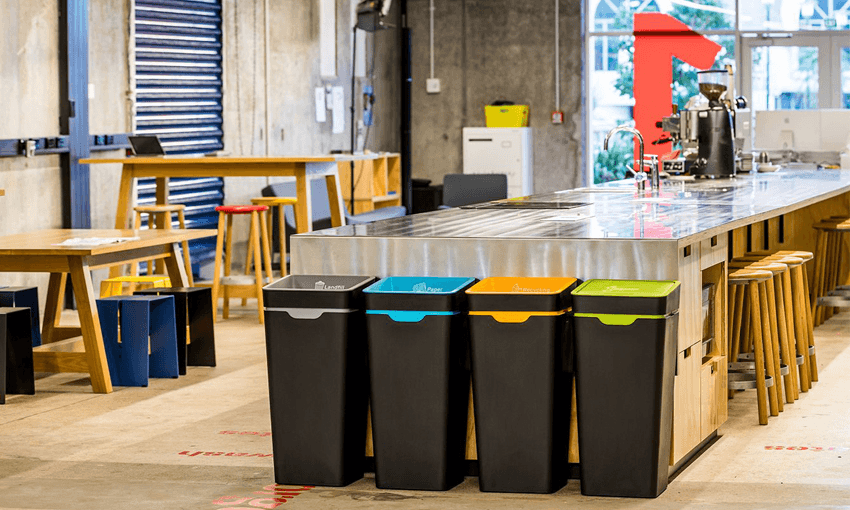Every week on The Primer we ask a local business or product to introduce themselves in eight simple takes. This week we talk to Steven Korner, co-founder of Method Recycling, whose aim is to encourage better waste disposal habits by making beautifully designed rubbish bins for modern workplaces.
ONE: How did Method Recycling start and what was the inspiration behind it?
In 2011, I was leading a team at Fisher & Paykel Healthcare designing products for neonatal care, while [Steven’s wife and Method co-founder] India was working as a commercial leasing broker after getting her graphic design degree. We were happy in our roles, but what we really wanted was somewhere we could work together while starting our family.
We took a risk and bought an existing company [Total Bins] selling bins to businesses. It was amazing getting to travel around New Zealand in our van selling bins, but soon enough our design brains were thinking about how we could make a difference. We kept seeing beautiful offices designed by incredible architects that had really ugly recycling bins, usually hidden away in cupboards. This caused employees to be disengaged with recycling and ignore the issue of sustainability in the workplace.
We knew that, with a bit of design thinking, we could create a beautiful solution that would drive behaviour change and successful sustainability outcomes.
TWO: Did you have any interest/experience in business or entrepreneurship prior to starting Method Recycling?
We’d always had the ambition to have a business together, but we weren’t exactly sure how the realities of a husband and wife team would work. Running our first small company together showed us that we could definitely do it.
India’s family have always been involved in business, so it was often a dinner table topic for us in our household. I was also a winner of an entrepreneurship competition at Canterbury University and really enjoyed reading biographies of successful business people.
THREE: What is the design thinking behind what makes Method Recycling bins work?
Design thinking is basically about fully understanding who you’re designing for. For Method, this means we’re always considering the stakeholders involved and ensuring that there’s ease of use for them – from staff using the bins through to the cleaners servicing the product.
We spent three years designing and testing our recycling bins before launching them. During customer research, I even did an overnight cleaning shift to understand all the steps involved in the role of a commercial cleaner, and how we could help them do their job more efficiently with our design. It was a long night! But from it, we got the idea for our patented Bag Retainer System, which is one of our bin’s defining features.
FOUR: How many different waste streams (soft plastic, landfill, organics etc.) does Method have?
Currently, our waste streams include Landfill, Organics, Recycling (Comingled), Recycling (Mixed), Recycling (Plastics + Cans), Glass, Paper, Soft Plastics and a Container Deposit scheme collection bin for Australia.
We also offer custom waste streams, like when we created a bin specifically for paper towels in the bathrooms of the Sydney Cricket Ground.
Our bins have been designed to be flexible for the future, with the ability to be customised as we work towards a circular economy.
FIVE: Who are some of the major local and international clients Method provides bins for?
We’ve worked with a range of international customers (corporates, banks, universities, architects) and our bins can be found in New Zealand, Australia, Hong Kong, Singapore, the UK and the US. They’re in places such as Wellington Airport, Te Papa, Auckland Museum, the University of Melbourne, and in the offices of Canva, IAG, Xero, TradeMe, and Ports of Auckland. Atlassian, the Australian tech company, actually found our recycling bins on Google images. They then bought them for their Sydney CBD office, which is really cool.
Recently we helped Palmerston North City Council reduce their landfill waste by 63% within six months of having their Method Recycling Stations. It’s amazing when we see these kinds of results, and reassures us that we’ve created a product that not only looks good but can really make a difference.
SIX: Method’s focus is on corporate offices, but would you consider developing products for more personal/household use?
We’d love to, but they’re totally different in product requirements and channels to market. This makes it a challenge, but not something we’d ever rule out completely.
SEVEN: Do you have any other plans to scale/grow further and if so, what are they?
At the moment we’re in the process of setting up a UK office in London. This has been made possible because of two high profile customers we’ve worked with there who are hugely influential. They’ve given us the confidence to take the risk and make the leap. Sustainability is a hot topic in the UK at the moment – we’re hoping we can be a part of that conversation.
EIGHT: Lastly, tell us about a local start-up or business that you really admire right now.
Auckland creative content agency Motion Sickness (who made our homepage video) and Goodnature for their considered design aesthetic.
The Spinoff’s business section is enabled by our friends at Kiwibank. Kiwibank backs small to medium businesses, social enterprises and Kiwis who innovate to make good things happen.
Check out how Kiwibank can help your business take the next step.
